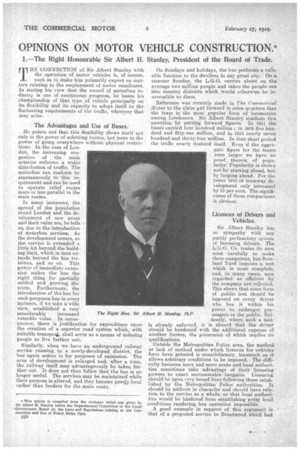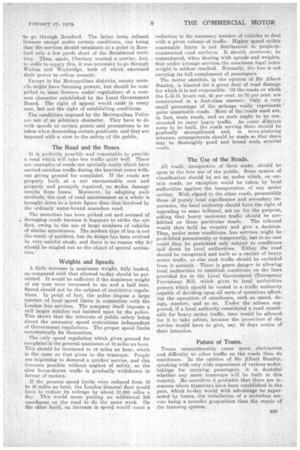OPINIONS ON MOTOR VEHICLE CONSTRUCTION.*
Page 8

Page 9

If you've noticed an error in this article please click here to report it so we can fix it.
1.—The Right Honourable Sir Albert H. Stanley, President of the Board of Trade.
THE CONNECTION of Sir Albert Stanley with the operation of motor vehicles is, of course, such as to make him primarily expert on matters relating to the employment of motor omnibuses. In stating his view that the record of motorbus industr,r is one of continuous progress, he bases his championship of that type of vehicle principally on its flexibility and its capacity to adapt itself to the fluctuating requirements of the traffic, wherever that may arise.
The Advantages and Use of Buses.
, He points out that this flexibility shows itself not only in the power of selecting routes, but more in the power of going everywhere without physical restrictions,. In the case of London, the increasing congestion of the main arteries enforces a wider distribution of traffic. The motorbus can conform instantaneously to this requirement and can be used to operate relief routes more or less parallel to the main routes.
In many instances, the spread of the population round London and the development of new areas and their value are, he tells ., us, due to the introduction of Motorbus services. As the development occurs, so the service is extended a little bit beyond the building limit, which in turn extends beyond the bus terminus, and so on. This power of immediate extension makes the bus the right thing for partially settled and growing "districts. Furthermore, the introduction of the bus for such purposes has in every instance, if we take a; wide view, established a very considerably increased rateable value. In consequence, there is justification for expenditure upon the creation of a superior road system which, with suitable transpor,t, shall serve as a means of inducing people to live further out.
Similarly, when we have an underground railway service running to a newly-developed district, the bus again comes in for purposes of extension. The area. of development is enlarged and, after a time, the railway itself may advantageously be taken further out. It does not then follow that the bus is no longer useful. The services may be maintained while their purpose is altered, and they become pureiy local rather than feeders for the main route. The Right Hon. Sir Albert H. Stanley,
. On Sundays and holidays, the bus performs a valuable function to the dwellers in any great city. On a summer Sunday, the L.G.O. carries about on the average two million people and takes, the people out into country districts which would therwise be inaccessible to them.
Reference was recently Made in The Commercial Motor to the claim put forward in some quarters that the tram is the most popular form of locomotion among Londoners. Sir Albert Stanley combats this assertion by putting forward figures. In 1911 the buses carried four hundred million ; in 1912 five hun dred and fifty-one million, and in 1913 nearly seven hundred and thirty-four million. In that short period the traffic .nearly doubled itself. Even if the aggregate figure for the trams were larger we have no proof therein of popularity. Popularity is shown not by starting ahead, but by forging ahead, For the years 1910-15 tramway development only inoreased. by 13 per cent. The significance of these comparisons is obvious.
Licences of Drivers and Vehicles.
Sir Albert Stanley has no sympathy with any purely perfunctory system of licensing drivers. The L.G.O. Co. trains its men most carefully to make them competent, but Scotland Yard imposes a test which is most complete, -and, in many cases, men regarded as efficient by the company are rejected. This shows that some form of public test should be imposed on every driver who has it within his power to endanger passengers or the public. Evidently, where such a test is already enforced, it is absurd that the driver should be burdened with the additional expense of another licence, the possession of which implies no qualifications.
Outside the Metropolitan Police area, the method or lack of method under which licences for vehicles have been granted is unsatisfactory, inasmuch as it allows arbitrary conditions to be imposed. The difficulty becomes more and more acute and local authorities sometimes take advantage of their licensing powers to exact unreasonable bargains Licensing should be upon very broad lines following those established by the Metropolitan Police authorities. It should be uniform in character and should have relation to the service as a whole; so that local authorities would be hindered from establishing petty local conditions rendering bus operation impossible.
A good example in support of this argument is that of a proposed service to Brentwood which had to go through Romford. The latter town refused licences except under certain conditions, one being that the services should terminate at a point in Bornford only a few yards short of the Brentwood territory. Then, again, Chertsey wanted a service, but, in order to supply this, it was necessary to go through Walton and Weybridge, both of which exercised their power to refuse consent.
Except in the Metropolitan districts, county councils might have licensing powers, but should be compelled to issue licences under regulation; of a common character established by the Local Government Board. The right of appeal would exist in every case, but not the right of establishing conditions.
The conditions imposed by the Metropolitan Police are not of an arbitrary character. They have to do with speeds at certain points and precautions to be taken when cdescending certain gradients and they are imposed with a view to the safety of the public.
The Road and the Buses.
It is perfectly possible and reasonable to provide a road which will take bus traffic quite well. There are examples of Toads not specially costly which have carried omnibus traffic during the heaviest years without giving ground for complaint. If the roads are properly built at a not unreasonable cost and properly and promptly repaired, no endue damage results from buses. Moreover,, by adopting such methods, the cost of road maintenance as a whole is brought down to a lower figure than that involved by the ordinary water-bound macadam road.
The motorbus has been picked out and accused of , damaging roads because it happens to strike the eye first, owing to the use of large numbers of vehicles of similar appearance. The modern type of bus is not the result of accident, but its design has been evolved by very oaieful study, and there is no reason why it should be singled out as the object of special accusation.'
Weights and Speeds.
A little increase in maximum weight, fully loaded, as compared with that allowed to-day should be permitted. It would be sufficient if the maximum weight of six tons were increased to six and a half tons. Speed should not be the subject of restrictive regulations. In point of fact, the police impose a large number of local speed limits in connection with the London bus services. The company itself imposes a still larger number not insisted upon by the police. This shows that the interests of public safety bring about the necessary speed restrictions independent of Government regulations. The proper speed limits automatically fix themselves.
The only speed regulation which gives ground for complaint is the general maximum of 12 miles an hour. This should be increased to 16 miles an hour, which is the same as that given to the tramcars. People are beginning to demand a quicker service, and this becomes possible without neglect of safety, as the slow horse-drawn traffie is gradually withdrawn in favour of motors.
if the present speed limits were reduced from 12 to 10 miles an hour, the London General fleet would have to reduce its mileage by about 21,000 miles a day. This would mean putting an additional 200 omnibuses on the road to do the same work. On the other hand, an increase in speed would mean a reduction in the necessary number of vehicles to deal with a given volume of traffic. Higher speed within reasonable limits is not detrimental to properly. constructed road surfaces. It should, moreover, be remembered, when dealing with speeds and weights, that under average services the maximum legal laden weight is seldom reathed. Normally, the bus is not carrying its full complement of passengers.
The motor omnibus, in the opinion of Sir Albert Stanley, is blamed for 6, great deal of road damage for which it is not responsible, Of the roads on which the L.G.O. buses run, 65 per cent. to 70 per cent. are constructed, in a first-class manner. Only a very smalr percentage of the mileage really represents. quite unsuitable roads. Most of the roads used are, in fact, main roads, and as such ought to he constructed to carry heavy traffic. As outer districts come to be built, the roads serving them should be gradually strengthened and, in town-planning schemes, arrangements should be made_ so that there may be thoroughly good and broad main arterial roads.
The Use of the Roads.
All roads, irrespective of their make, should be Open to the free use of the public. Some system of classification should be set up under which, on certain roads, no exception could be taken by local authorities against the inauguration of any motor service. With regard to the other roads, presumably those of purely local significance and secondary importance, the local authority should have the right of appealing to some tribunal, set up for the purpose, asking that heavy motorcar traffic should be pro hibited on those particular roads. The tribunal would then hold an enquiry and give a decision. Thus, under some conditions, bus services might be prohibited permanently, or temporarily, bat in no case could they be permitted only subject to conditions laid down by local authorities. Either the road should be recognized and built as a carrier of heavy motor traffic, or else such traffic should be excluded from it entirely. There is grave danger in allowing local authorities to establish conditions on the lines provided for in the Local Government (Emergency Provisions) Bill, which gives to local authorities powers which should be vested in a traffic authority capable of deciding upon all sorts of questions affecting the operation of omnibuses, such as speed, design, number, and so on. Under the scheme suggested, if a local authority considered a road unsuitable for heavy motor traffic, time would be allowed for it to -take action, because the prometers of the service would have to give, say, 30 days notice of their intention.
Future of Trams.
Trams unquestionably cause more obstruction and difficulty to other traffic on the roads than do omnibuses. In the opinion of Sir Albert Stanley, speaking with very wide experience of various undertakings for carrying passengers, it is doubtful whether any more tramways will be built in this country. He considers it probable that there are instances where tramways have been established in the past, which to-day would with advantage be superseded by buses, the installation of a moterbus service being a 'sounder proposition than the repair of the tramway system.






















